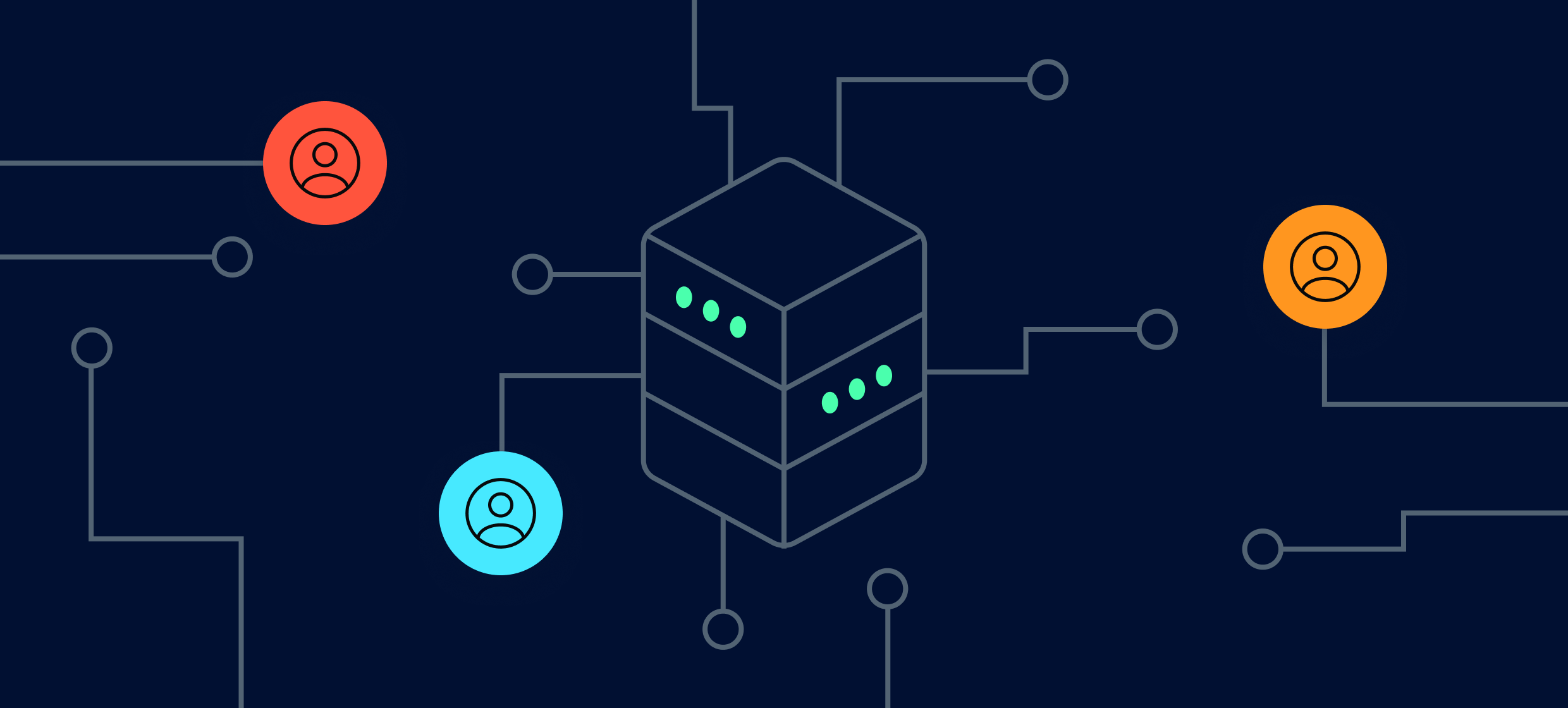What is a Shared Proxy?
A shared proxy is a proxy server that multiple users access at once. Users connect through the same IP address. Unlike dedicated proxies assigned to one user, shared proxies split their resources among several clients. This makes them an economical option for users who need simple proxy features.
The shared proxy server works as a middleman between users and websites. Each request through the proxy hides the user's original IP address and uses the shared one instead. The websites see the same IP address for all users behind the proxy, whatever their actual locations or identities. If you need stronger privacy guarantees, some users step up to anonymous proxies or even elite proxies for tighter anonymity.
The proxy's technical architecture uses connection multiplexing to handle multiple user sessions at once. This feature became possible after HTTP/2 came along, which lets multiple requests and responses travel over the same TCP connection. The server manages traffic flow to the internet, gets responses, and sends them back to the right users. Each session stays separate with unique identifiers.
Key Characteristics of Shared Proxies:
- Multiple users share one IP address at the same time
- Costs less than dedicated options as users split the expenses (and can be even cheaper via bulk proxies)
- Offers decent anonymity, but shared access means user activities might overlap
- Providers set bandwidth limits and usage rules to stop misuse (or offer unlimited bandwidth proxies on certain plans)
Shared proxies come with their trade-offs. They offer economical solutions for simple web tasks, but speed can drop since all users share the bandwidth. On top of that, the IP address risks getting banned if other users on the same proxy break website rules.
These proxies usually come from datacenter addresses - IPs owned by cloud hosting companies. Residential and mobile IPs are shared too, but the proxy market calls them something else. Many users think "shared" means "affordable," which doesn't apply to residential and mobile proxies.
Proxy providers base their pricing on access to shared proxy networks. Their IP pools can reach thousands or tens of thousands. They place reverse proxies between users and shared servers to distribute resources better and prevent overload. This setup helps them scale operations and redirect traffic if a shared server stops working.
Types of Shared Proxies
Shared proxies come in different types based on their protocol, how they rotate, and the way people share them. Each type has its own special features and best-fit scenarios.
HTTP Proxies
HTTP proxies work with the Hypertext Transfer Protocol to handle communications. They serve as both HTTP clients and servers that route user requests and hide their actual IP addresses. These proxies can screen content and let only approved files move through. They create a security wall by spotting suspicious content and unusual protocol behavior. HTTP proxies boost operations by compressing web traffic, caching files, and cutting down ads. Multiple users can work with them at the same time, which makes them perfect for companies with large teams. Learn more about http proxies.
SOCKS4 and SOCKS5 Proxies
SOCKS (Socket Secure) proxies are network protocols that let data flow between devices through a third-party server. SOCKS4 and SOCKS5 both hide real IP addresses and help users get past geo-blocks. SOCKS5 builds on SOCKS4 with better authentication and UDP protocol support. SOCKS4 runs only on TCP connections. SOCKS5 handles both TCP and UDP traffic, which makes it great for heavy-bandwidth tasks like streaming, torrenting, and VoIP. These proxies don't look at the traffic between client and server - they just pass packets along. The biggest problem is security since they lack built-in tunnel encryption, which could expose data and login details.
Static Shared Proxies
Static shared proxies keep the same IP address until someone changes it manually. Users get their IP addresses in a text file. These proxies excel in situations that need a steady identity - to name just one example, see gaming or managing accounts. They work best with session-based activities or services that need stable IPs. Static proxies aren't the best choice for tasks like web scraping where changing IPs helps avoid detection. Users pay for each IP address they use.
Rotating Shared Proxies
Rotating shared proxies switch IP addresses automatically based on time or connection requests. Users connect through a backconnect gateway server (e.g., en.proxyprovider.net:10000) that links to the provider's proxy pool. Two main types exist: one gives new IPs for every request, while sticky sessions keep the same IP for a set time before changing. This automatic switching makes them ideal for web scraping and data collection. Users pay based on traffic instead of individual IPs.
Pros and Cons of Shared Proxies
Shared proxies come with unique advantages and disadvantages that determine how well they work for different uses. Let's look at what makes them suitable for your needs.
Pros: Economical solutions and easy to access
Shared proxies are popular because they're affordable. Multiple users split the costs of setup and maintenance, which makes them substantially cheaper than dedicated options. These economical solutions help new users start their journey into proxy services. The plug-and-play nature of shared proxies means you don't have to deal with complex technical setups. Users can start using them right away since they don't require complicated configuration. Paid plans from reputable providers (i.e., paid proxy servers) also reduce risk versus free lists.
Pros: Simple anonymity and geo-unblocking
These proxies hide your real IP address well, even though multiple people use them. The shared IP setup can actually improve your anonymity because it's harder to track individual users. Shared proxies are great at getting around geographic restrictions and letting you access region-locked content from streaming services and websites. They help you bypass simple web filters and reach content that's blocked in certain locations.
Cons: Slower speeds due to shared bandwidth
The downside is that shared proxies aren't as fast as dedicated ones. Your connection speed varies because you share bandwidth with other users. You'll notice this more during busy times, which can lead to delays or temporary connection drops. The speed issues become obvious when you're doing data-heavy tasks or when many people use the proxy at once.
Cons: Risk of IP bans from bad neighbors
The "bad neighbor" problem is another big issue. One user's suspicious activity can get the IP flagged or banned, especially when it breaks website rules. This affects everyone using that shared proxy, and they lose access to those websites. You'll run into more CAPTCHAs and security checks. When that happens, specialized setups like captcha proxies can help reduce friction.
When to Use Shared Proxies
You should know what shared proxies can and cannot do before deciding when to use them. These budget-friendly IP solutions work best when you value cost savings over performance.
Trying web scraping for the first time
Shared proxies give new web scrapers a great starting point. Their low cost makes them perfect to experiment and learn without spending too much. These proxies help you test scraping tools and methods when you're just getting started with data extraction. They work well with websites that have simple protection measures or lesser-known sites without complex anti-bot systems. New users can learn rotation techniques and request management before moving to better proxy types.
Accessing geo-restricted content on a budget
A key use of shared proxies helps users bypass location-based content blocks without breaking the bank. You can watch region-locked streaming services, news sites, or online platforms that restrict content by location. Shared proxies let you see content as it appears in other countries affordably. This feature helps if you want to access your home country's services while traveling or check out content from other countries. Many sources agree that shared proxies remain the most budget-friendly way to handle simple geo-unblocking needs.
Running small-scale automation tasks
Shared proxies fit well with lightweight automation projects where occasional connection problems won't hurt your operations. They handle smaller tasks like simple social media management, basic forum posting, or limited data collection well. These proxies work reliably enough for projects that don't use much bandwidth or can handle occasional performance issues. For niche automation, consider role-specific choices such as sneaker proxies for drops, or mobile proxies when you need carrier-grade NAT trust.
Monitoring prices or content from different regions
Price monitoring in international markets shows another practical use for shared proxies. Companies track how competitors price products in different regions. Marketing teams can check location-specific promotions, special deals, or regional pricing strategies without expensive proxy costs. E-commerce sellers benefit especially when they track marketplace listings or promotional offers in various currencies. Shared proxies also help research price differences and discrimination practices in different markets.
FAQs
What is the main difference between shared and dedicated proxies?
Shared proxies are used by multiple users simultaneously, sharing the same IP address, while dedicated proxies are exclusively assigned to a single user. This makes shared proxies more affordable but potentially slower due to shared bandwidth.
Are shared proxies suitable for web scraping?
Shared proxies can be suitable for beginners trying web scraping for the first time. They offer an affordable way to experiment with data extraction techniques, especially when targeting websites with basic protection measures. However, they may not be ideal for large-scale or advanced scraping projects, where rotating ISP proxies or residential rotations are a better fit.
Can shared proxies help bypass geo-restrictions?
Yes, shared proxies are effective for bypassing geographical content restrictions on a budget. They allow users to access region-locked streaming services, news sites, or online platforms, making them useful for viewing content from specific countries without premium costs.
What are the risks associated with using shared proxies?
The main risks of using shared proxies include slower speeds due to shared bandwidth, potential IP bans caused by other users' activities (the "bad neighbor" effect), and a higher likelihood of encountering CAPTCHAs or other protection mechanisms on websites with strict anti-bot measures.
What types of shared proxies are available?
There are several types of shared proxies, including http proxies for web traffic, socks5 proxies for various protocols, static shared proxies that maintain the same IP address, and rotating shared proxies that automatically change IP addresses at set intervals or with each request. For mobile-origin traffic and stability, look at static mobile proxies as well.






















.svg)